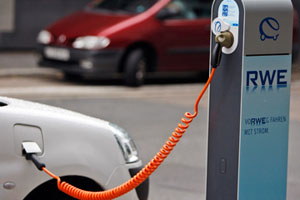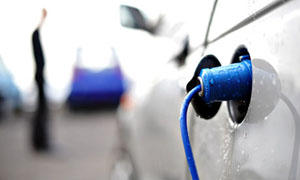The coming breakdown of the power grid (Or: why electric cars can work only if consumers turn to smart charging)
on
The coming breakdown of the power grid (Or: why electric cars can work only if consumers turn to smart charging)
If millions of Germans were to switch to electric cars, would this put an unbearable strain on Germany's power generation capacity? Not at all, says German technology executive and Eurelectric specialist Peter Birkner. But it would lead to a breakdown of the power grid. There is only one solution, according to Birkner: the widespread introduction of smart charging systems. The consumer will have to become an integral part of the electricity system.
 |
| Widespread introduction of smart charging systems |
The German automotive club ADAC estimates that there are currently 51 million cars on the road in Germany. With most of these vehicles used in urban transport, a significant portion of Germany’s automotive fleet will have to convert to electric charging over the next twenty years and beyond. There is just one problem: the unprecedented demand this scenario creates for electrical power would quickly overwhelm Germany’s existing electricity grid.
“In the next ten years our challenge is more about grid capacity than energy”, says Dr. Peter Birkner, chairman of the Networks Committee of industry association Eurelectric. “We are increasingly living on the reserves of our grid capacity.”
More than adequate
It may come as a surpise to some, but according to Birkner, who is also a board member at the Frankfurt-based energy supplier Mainova AG and former managing director at an RWE-owned grid
| Birkner calculates that if every driver in the EU-27 bloc converted to fully electric engines tomorrow, Europe-wide electricity demand would increase by only about 15 percent |
Germany’s gross electricity generation totalled almost 640 TWh in 2008, according to the Federal Statistical Office. This figure is widely used as a baseline, although more recent estimates by the Federal Ministry of Economics and Technology (BMWI) put the figure at approximately 625 TWh in 2010. Coal-fired power plants remain Germany’s top electricity source with 42 percent of the total supply, followed by nuclear (23 percent), natural gas (13 percent) and renewables (16 percent).
The situation is similar for Europe as a whole. Birkner calculates that if every driver in the EU-27 bloc converted to fully electric engines tomorrow, Europe-wide electricity demand would increase by only about 15 percent, or 470 TWh from the 2005 baseline of approximately 3,100 TWh. He fully expects that new generation technologies will have enough time to penetrate the markets and satisfy Europe’s efficiency, greenhouse gas-reduction and renewable-energy targets.
“E-mobility is not primarily an energy issue”, he concludes. But that doesn’t mean it can be introduced just like that. The problem, Birkner says, lies in balancing the daily load patterns on the grid. If millions of Europeans came home from work in the early evening hours and plugged in their electric vehicles all at once, there wouldn’t be an electric grid in all of Europe that could sustain the resulting peak load.
Network collapse
Birkner cites a pilot project in the Netherlands as an example of the challenges posed by the large-scale introduction of electric vehicles. The Dutch experiment demonstrates that a civilian auto fleet comprised of 20 percent electric vehicles already doubles the grid’s peak load between six and nine p.m. to levels well beyond safe and stable operation. Under these circumstances, “fast-charging electric-vehicle stations could easily lead to a network collapse“, Birkner says.
What complicates matters is that Germany, through its ambitious renewable energy policies, has also embarked on a massive expansion of intermittent renewable power sources, which is placing a huge
| If millions of Europeans came home from work in the early evening hours and plugged in their electric vehicles all at once, there wouldn't be an electric grid in all of Europe that could sustain the resulting peak load |
“With respect to distribution, onshore wind parks often consist of a few generators placed on hills in areas without any lines so far”, Birkner says. Wind energy is fed into both the transmission and distribution lines on the grid. The energy needs to traverse high or medium-voltage lines and is then converted to low-voltage systems for end-user consumption. As a result, bottlenecks occur on both the transmission and distribution levels.
Electricity feed-in from solar power sources creates similar problems for the grid. Given the current infrastructure, the strains that these intermittent power sources place on the electricity grid far exceed the amount of electricity actually being consumed. “Photovoltaic power currently generates about two percent of German electricity consumption, but it accounts for almost 20 percent of installed grid capacity”, Birkner says.
Prosumer
According to Birkner, there is only one way to accommodate both the new renewable energy sources and the introduction of e-mobility: through the widespread rollout of “smart charging” systems. Smart-charging systems work by dynamically regulating the charging speed of individual vehicle stations based on overall grid utilization. In such a system, “private households have to become a part of the power balancing procedure through automated systems that not only consume but also store, produce and re-distribute energy.”
Birkner points out that traditionally in the electricity sector supply has followed demand. “With the German government’s goal of 80 percent renewable energy in the mix by 2050, and the widespread introduction of e-mobility, that approach is no longer feasible“, he says. “Generation and consumption are both becoming more volatile, and future demand has to adapt in some part to the available electricity.” This new situation has to be dealt with through demand-side management, in which the end-user becomes what Birkner calls a “prosumer,” or part consumer, part producer.
Birkner sees no realistic alternatives to smart charging. According to his calculations, a hypothetical
| "Gas power plants are losing money today, because solar energy takes away the midday peak" |
By the same estimate, slow domestic charging of one million vehicles for a distance of 100 kilometres consumes roughly 3,700 megawatts (MW), or 4.1 percent of Germany’s total generation capacity. With one 16-ampere charger at 230 volts, it would take approximately four hours to refuel a vehicle for this distance. By contrast, a fast-charging station using three 63-ampere units at 230 volts provides the same charge in just 20 minutes, but at a dramatically higher power consumption rate of 44,000 MW in total, or 48.9 percent of Germany’s overall generation capacity.
Range extenders
Birkner notes that the smart charging systems of the future will not only include automated charging systems in people’s homes, they will also make use of the electric cars themselves. The vehicles can double as energy-storage devices to support load balancing on the grid. He predicts that electrically-charged vehicles will provide not only low-noise and carbon-free urban transport but also a “distributed mass storage system”: a virtual array of plug-in vehicles that would act as a massive battery to support the balancing of peak loads on the grid.
The potential energy-storage capacity from electric vehicles is significant. “660,000 vehicles plugged in for charging or discharging with 10 kilowatts provide about the same power as all German hydro-pump storage plants combined”, Birkner says. Germany’s hydro-pump storage capacity currently amounts to 42 gigawatt-hours, or 7,000 megawatts per six-hour cycle. “In principle, this power can support grid balancing for about one hour when 50 percent of the battery capacity is used.”
Under the assumption that 80 percent of the average motorist’s trips are for distances of 100 kilometres or less per day, Birkner claims that half a battery charge over a period of several hours is sufficient. For long-distance journeys, he envisions the use of so-called “range extenders.” These small fossil-fuel motors are built into electric vehicles and, together with recuperated energy from the car’s brakes, generate electricity whilst driving to enable longer distances per charge. “However, we should not underestimate the logistics we need for implementing this system“, Birkner adds.
Some experts are enthusiastic about the idea of combining intermittent renewable energy supplies with the storage capacities of electric cars. Berlin’s Technical University recently conducted a study on the implementation of renewable-energy supplies in the capital by the year 2037, which will mark Berlin’s 800th anniversary. The study, which received a 140,000-euro grant from Siemens and Vattenfall, posits that “smart charging enables electric vehicles to be charged primarily with renewable energy and to be used as storage for wind and solar-generated electricity.” The study estimates that this would lower Berlin’s electricity-related greenhouse-gas emissions by 14 percent compared to unregulated charging.
Natural gas
 |
Although gas-fired power plants are providing vital reserve capacities for electricity generation, “the markets currently do not reward this flexibility“, Birkner says. “Gas power plants are losing money today, because solar energy takes away the midday peak.” In other words, gas operators are unable to sell their electricity when prices are high because solar power serves that market more effectively.
“What we really need right now”, says Birkner, “is a capacity market where system operators can purchase excess capacities.” Birkner proposes a “capacity premium” to the tune of about 25 percent of the price of electricity in order to guarantee stability in the German power system.
Another crucial question of course is whether consumers will go along with the changes imposed on them. They may baulk at the idea of slow-charging their vehicles and using battery capacity in their cars to provide electrical storage, not to mention at the price rises of electricity that are expected in the coming decade. Birkner concedes that “there are additional questions of privacy and other issues that need to be resolved”, and indeed much of the technology has yet to be fully developed for mass-market deployment. “But consumers have to understand that they will be required to make a contribution.”
|
|
|
Green transport will save €200 billion annually The Roadmap to a Single European Transport Area, published by the European Commission in March of this year, contains a lot of entertaining facts and figures on European transport and mobility issues. It notes, for intsance, that at this moment, 96% of transport in the EU depends on oil and oil products. Europe imports around 84% of its crude oil, at a cost of some €210 billion (2010). Green technologies offer European companies a huge commercial opportunity, says the Commission. Among other things, it refers readers to a 424-page report on Green Tech Made in Germany. This 424-page Environmental Technology Atlas for Germany can be consulted free of charge on the internet! |


Discussion (0 comments)